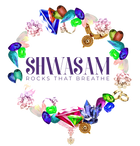In the Earth, there are many gemstones which attract gemstone lovers, gem scholars and gemologists. So let's delve into the mysterious allure of moonstone and unveil its origins, basking in its ethereal glow. We'll explore its unique properties, benefits and pivotal role in crystal healing.
Whether you're a crystal enthusiast a jewelry aficionado or simply curious about the wonders of nature, come along as we unravel the secrets of moonstone. Its luminous sheen and enigmatic energy have captivated minds for centuries offering not just aesthetic beauty but also a connection to the celestial realms.
Join us on this journey of discovery and enlightenment.

Click to here shop this Moonstone Ring in 925 silver
What is Moonstone?
Moonstone is a gemstone that belongs to the feldspar mineral family. It is characterized by its opalescent sheen, which gives it a mystical appearance reminiscent of moonlight. This unique optical phenomenon, known as adularescence, occurs due to the interplay of light with the alternating layers of orthoclase and albite within the stone. Moonstone is typically translucent with a pearly white or cream color, although it can also be found in shades of peach, gray, and rainbow hues.

Where is Moonstone Found?
Moonstone can be found in various parts of the world, with each location producing stones of unique quality and appearance. Some of the most notable sources of moonstone include Sri Lanka, India, Myanmar, Brazil, and Madagascar. Sri Lankan moonstones are highly prized for their blue sheen and exceptional clarity. Indian moonstones, on the other hand, are known for their peachy hues and warm glow. Myanmar produces moonstones with a striking cat's eye effect, while Brazilian and Madagascan moonstones often display a vibrant rainbow play of color.

Historical Significance of Moonstone
Moonstone has a rich and storied history that spans across cultures and civilizations. In ancient times, it was believed to be a stone of protection, particularly during travel at night. It was thought to guide and illuminate the way, ensuring a safe journey. Ancient Romans believed that moonstone was formed from the rays of the moon, giving it its otherworldly glow. In Greek mythology, moonstone was associated with the goddess Selene, who was believed to drive her moon chariot across the night sky. Moonstone has been revered in India for centuries as a sacred gemstone, associated with the divine feminine energy and believed to bring good fortune.
Physical and Healing Properties of Moonstone
Moonstone is believed to possess a range of physical and healing properties. It is thought to have a soothing and calming effect on the body, relieving stress and anxiety. Moonstone is always women's favorite because of its feminine energy. It is also believed that wearing this gemstone in the form of jewelry gives confidence, luck, and boosts your presence in a crowd. In crystal healing, Moonstone is revered for its ability to enhance intuition, promote inner growth, and balance emotions. It's said to soothe stress, aid in fertility, and foster creativity. This iridescent gem holds a mystical allure, captivating hearts and minds with its ethereal charm and spiritual significance.

Moonstone in Jewelry and Fashion
In the early 20th century, moonstone gained popularity during the Art Nouveau movement, with designers incorporating its ethereal beauty into their jewelry creations. Today 21st century, moonstone continues to captivate, as it is cherished for both its ethereal beauty and unique metaphysical properties.
From delicate rings and earrings to statement necklaces and bracelets, moonstone is a versatile gemstone that can be incorporated into various jewelry designs. Its soft, feminine glow adds a touch of elegance and mystique to any ensemble. Moonstone is also a favorite among fashion designers, who often incorporate it into their collections to create fantasy and whimsical looks. Whether worn as a personal talisman or a fashion statement moonstone is sure to inspire.
Moonstone vs Other Gemstones
While moonstone possesses its own unique charm, it is often compared to other gemstones due to its similar appearance. One such gemstone is opal, which also exhibits a play of light and iridescence. While both moonstone and opal share a magical quality, they differ in composition and origin. Moonstone is a feldspar mineral, whereas opal is formed from hydrated silica. Moonstone's adularescence is caused by light interacting inside the stone, while opal's play of color comes from tiny, colorful particles inside the stone. Each gemstone has its own distinct properties and symbolism.

How to Choose and Care for Moonstone
When selecting a moonstone, there are a few factors to consider to ensure you choose a high-quality gemstone. Look for stones with a strong adularescence and vibrant play of light. Moonstones with a translucent appearance and minimal inclusions are generally considered more valuable. It is also important to choose a moonstone that resonates with you on a personal level. Trust your intuition and select a stone that speaks to you energetically.
To care for your moonstone, it is important to handle it with care. Moonstone has a hardness of 6 on the Mohs scale, which means it is relatively soft and can be easily scratched. Avoid exposing your moonstone to harsh chemicals or extreme temperature changes, as these can damage the stone. To clean your moonstone, simply use a soft cloth or brush and mild soapy water. Avoid using ultrasonic cleaners or steamers, as they can also cause damage. With proper care, your moonstone will continue to shine and enchant for years to come.

Whether you are drawn to moonstone for its physical healing properties, emotional and spiritual significance, or purely its aesthetic appeal, this gemstone is sure to leave you spellbound.
Excited to embrace the magic of moonstone? We would love to help you find the most beautiful moonstone jewelry from independent jewelers. Get in touch now
 USD
USD EUR
EUR
 AUD
AUD
 GBP
GBP
 INR
INR


